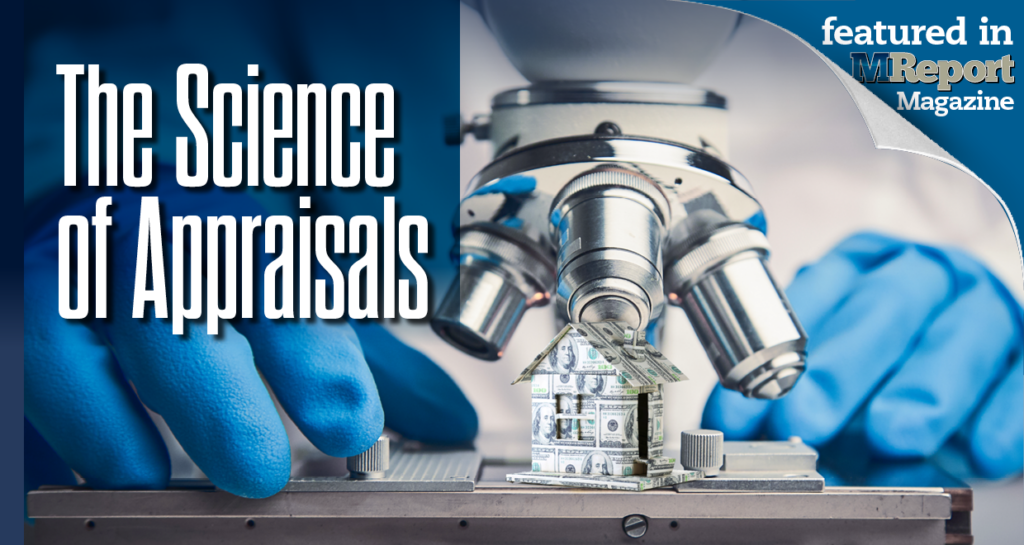This piece originally appeared in the January 2023 edition of MReport magazine, online now.
The property valuation process, specifically appraisals and automated valuation model (AVM) algorithms, has come under attack of late as discussions around potential bias and/or discrimination in housing markets have come into the spotlight.
Coming out of the pandemic and the housing boom it brought along with it, appraiser demand was at an all-time high. Millions jumped aboard record-low mortgage rates for purchase loans or refis, but a dilemma emerged. How could the mortgage closing process be effectively performed if states began to enact social distancing mandates?
How could an appraiser effectively perform their role, a function vital to the homebuying process, amid new rules and regulations?
The U.S. Department of Housing & Urban Development (HUD) issued Mortgagee Letter 2020-05, applicable to FHA Single-Family Title II Forward and Reverse Mortgage Programs, where the appraiser was able to amend the scope of work to perform an Exterior-Only (viewing from the street) or Desktop-Only appraisal. Mortgagee Letter 2020-05 allowed the appraiser to rely on supplemental information from other reliable sources, such as Multiple Listing Services (MLS), and Tax Assessor’s Property Records to prepare an appraisal report. The appraiser was also able to rely on information from an interested party to the transaction (borrower, real estate agent, property contact, etc.) with clear appraisal report disclosure when additional verification was not feasible. (Note: this only applied to FHA loans, not to Fannie Mae or Freddie Mac loans. Fannie Mae issued Lender Letter LL-2020-04, Impact of COVID-19 on Appraisals, in March 2020 and with multiple later updates, to provide temporary policy flexibilities allowing exterior-only inspection appraisals or desktop appraisals on many loans sold to Fannie.)
Mortgagee Letter 2020-14 (ML 2020-14) was later issued to extend the regulations set forth by ML 2020-05, followed by additional extensions for appraisers with ML 2020-20, ML 2020-47, and ML 2021-06.
However, as the industry adjusted and the housing market boomed, concerns about appraisal bias became a hot-button topic.
The 2019 Survey of Consumer Finances found that white families on average held $983,400 in wealth, compared to $142,500 for Black and $165,500 for Latino families, respectively. For most Americans, the largest driver of wealth is their home, making unbiased home valuations critical.
A recent study by the Federal Housing Finance Agency (FHFA), examining more than 47 million appraisals conducted between 2013 and June 30, 2022, provided some vital insights into potential appraisal bias concerns.
In addition to the FHFA’s findings, the Brookings Institute showed a correlation between lower valuations and Black neighborhoods in their November 2021 report, “Biased Appraisals and the Devaluation of Housing in Black Neighborhoods.” Brookings reporters Jonathan Rothwell, Nonresident Senior Fellow, Brookings Metro, and Andre M. Perry, Senior Fellow for Brookings Metro, in their analysis found that Black neighborhoods were associated with much lower property values overall, and only some of this was explained by physical characteristics and neighborhood amenities.
Median home values in majority Black census tracts were 55% lower than median home values in non-Latino or Hispanic white census tracts, according to the Brookings Institute findings. Part of this difference was attributed to quality differences between the housing stock. The authors concluded that lower wealth in Black communities meant that homes in majority Black neighborhoods tended to be older, smaller, and more likely to be attached than homes in neighborhoods with few or no Black people. Lower wealth and lower home values further hinder the ability of Black homeowners to pay for structural improvements to their homes and access mortgage refinancing to pay for renovations.
Further lending credence to the appraisal bias argument, Chandra Broadnax, Senior Examination Specialist from the FHFA’s Office of Fair Lending Oversight, Division of Housing Mission and Goals, highlighted examples of overt references to race in appraisals and the importance of appraisals in the discussion of wealth inequality in a blog titled “Reducing Valuation Bias by Addressing Appraiser and Property Valuation Commentary,” originally published on FHFA.gov.
Additional appraisal bias concerns were addressed by the government-sponsored enterprises (GSEs), as Freddie Mac’s research showed that properties in minority tracts are more likely than properties in white tracts to receive an appraisal lower than the contract price in the GSEs’ September 2021 report titled, “Racial and Ethnic Valuation Gaps in Home Purchase Appraisals.”
In the report “Appraising the Appraisal,” by Jake Williamson, SVP, Single-Family Collateral Risk Management, Fannie Mae, and Mark Palim, VP and Deputy Chief Economist, Fannie Mae, four major findings came to light:
- Black borrowers refinancing their homes on average received a slightly lower appraisal value relative to automated valuation models. According to an analysis of 1.8 million appraisals conducted as part of refi applications in 2019 and 2020, white borrowers refinancing their homes on average received a slightly higher appraisal value relative to the models. This was true for homes in both majority-white and majority-Black neighborhoods.
- Homes owned by white borrowers were more frequently overvalued than homes owned by Black borrowers. Overvaluations of white-owned homes were present at a higher rate in all neighborhoods but were more likely to occur among homes owned by white borrowers in majority-Black neighborhoods. Overvalued equated to an appraised value nearly 10% higher than the automated valuation models.
- The frequency of “undervaluation” did not have a notable racial pattern. Undervaluation of Black-owned homes occurred at the same rate as white-owned homes in neighborhoods comprised of predominantly white households.
- In majority-Black neighborhoods, the frequency of undervaluation for Black and white homeowners was within a percentage point of each other. “Undervalued” equated to an appraised value at least 10% lower than the automated valuation models.
- Six states accounted for nearly 50% of the overvalued homes of white owners in majority-Black neighborhoods. These states were found to be Georgia, Louisiana, South Carolina, North Carolina, Mississippi, and Alabama.
Observers feel that increasing diversity in the appraisal profession may help alleviate appraisal bias. The Urban Institute found that three in four employees in real estate are white, compared with 63% in the private sector. But according to Urban Institute calculations of 2019 American Community Survey data, this gap is even more pronounced for appraisers, as 89% of all property appraisers and assessors at the time of the report were white, while only 2% were Black and 5% Hispanic—estimates consistent with industry and occupation reports by the Bureau of Labor Statistics (BLS).
Making strides in diversifying the appraisal space is the Appraiser Diversity Initiative, a program spearheaded by the Appraisal Institute, Fannie Mae, Freddie Mac, and the National Urban League, established to attract new entrants to the real estate appraisal field while promoting diversity in the appraisal profession.
Working through the National Urban League’s regional Entrepreneurship Centers, the Initiative is designed to reach diverse, talented candidates and educate them about the appraisal profession; provide resources for interested candidates to help them get on a path to success; and offer guidance from appraisers employed by the government-sponsored enterprises.
MReport had the opportunity to chat with Fannie Mae’s Williamson and Appraisal Institute President Craig Steinley, MAI, SRA, AI-GRS, AI-RRS, about the topic of appraisal bias, the state of the appraisal industry, and what lies ahead in 2023.

In his role with Fannie Mae, Williamson is responsible for oversight and management of all end-to-end collateral capabilities. These duties include front-end collateral policy design, loan quality control activities for both credit and collateral, property valuations and valuation modernization, real estate liquidation options and Single-Family operational risk oversight. He is also responsible servicing strategy alignment and for performance management of the real estate agents, appraisers, and vendors.
As 2023 President of the Appraisal Institute, Steinley serves on the Institute’s Executive Committee and chairs the policy-setting Board of Directors. His previous national service includes six years on the Appraisal Institute Board of Directors as a representative from Region II, both as its Vice Chair and Chair. He served on the Audit Committee, including roles as Chair and Vice Chair; on the Strategic Planning Committee; on the Professional Liability Insurance Program Committee; as Region II Third Director; on the Governance Structure Project Team; and on the Professional Standards and Guidance Committee. He also served as President of the Wyoming and Western South Dakota Chapter in 2012 and 2013. Steinley is the Principal of Steinley Real Estate Appraisals and Consulting in Rapid City, South Dakota. He has also been active in the appraiser regulatory arena since the mid-1990s, including service as the 2018 President of the Association of Appraiser Regulatory Officials.
What is the current state of the appraisal marketplace as we head into 2023?
Williamson: Building on the lessons we’ve learned through testing different valuation approaches, we’ll continue to introduce updated valuation modernization options this year.
In addition, Fannie Mae and Freddie Mac are working jointly on the Uniform Appraisal Dataset redesign, which will establish a more flexible, dynamic structure for appraisal reporting as well as create greater consistency in data collection and standards.
Lastly, we expect to see the industry momentum continue with trainee days at industry events and continued outreach to draw new participants into the appraisal profession through ADI.

Steinley: The Appraisal Institute is excited about what this year has in store for appraisers. We are working to modernize our education delivery systems, revamp our website, and launch an all-new training module in the Appraisal Institute Practical Applications of Real Estate Appraisal (AI PAREA) program.
Along with continuing to address unconscious bias in appraisal and working with legislators and regulators at the federal and state levels on issues such as appraisal regulation, the key challenge we currently face is the aging of the profession.
I believe that the Appraiser Diversity Initiative will continue to be a major step forward, as AI, Fannie Mae, Freddie Mac, and the National Urban League collaborate to attract new entrants into the profession.
I’m excited and optimistic about the future of appraisal, and AI must continue to serve as the valuation profession’s thought leader. Working as an appraiser provides so many amazing opportunities, including flexibility, a variety of assignments, and good earning potential. I believe that this is a terrific profession, both for recent college graduates, younger professionals, and those who are looking for a mid-career change. The Appraisal Institute website (AppraisalInstitute.org) is a great place to learn more about the profession and the great things that will be happening in the coming year.
As the spotlight shines increasingly on appraisal bias, have instances of such bias dropped off, or do they remain the same?
Williamson: I am excited about the steps the industry and Fannie Mae are taking to reduce the instances of appraisal bias. For us, one key component is leveraging our database of appraisals to analyze and track factors that could indicate instances of bias, including random and targeted quality control reviews of appraisals on loans we acquire. Through our established Appraiser Quality Monitoring (AQM) process, we’re able to identify individual appraisers whose appraisal reports exhibit a pattern of inconsistencies, inaccuracies, or data anomalies, which we share with the appraisers as an opportunity for them to improve their work.
In addition to our routine AQM process, which focuses very heavily on mis-valuation issues, in 2021, we scanned 14 million appraisals from 2019–2020 to determine the extent of appraisers using unacceptable words and language specifically prohibited in Fannie Mae’s Selling Guide, and then shared feedback letters with appraisers who had a high frequency of findings.
We conducted our second round of text scanning on appraisals in the fall of last year, examining the most recent 18 months of appraisals, and found that the number of appraisers with findings has dropped significantly.
Nearly 80% of the appraisers who previously received a feedback letter did not have a new finding. While the vast majority of appraisers do comply with our Selling Guide policies, we are continuing to conduct text scans of appraisals and provide feedback to appraisers, as needed, on an ongoing basis.
Steinley: When we see even one story of a consumer who feels they were treated differently because of their race, it’s upsetting because that goes against everything appraisers stand for.
The Appraisal Institute continues to work toward broader solutions to improve diversity, equity, and inclusion in housing to root out unconscious bias. An appraisal is one piece of a larger ecosystem to look at when it comes to housing issues. Appraisal groups are working alongside consumer groups, real estate brokers and agents, banks, government agencies, think tanks, and others to explore where housing inequities may stem from and what combination of solutions should be considered.
What is the industry doing in terms of combating instances of appraisal bias?
Williamson: Fannie Mae is continually engaging with stakeholders and our lender partners to understand and reduce potential instances of bias within the appraisal process, as well as listening to what consumers are experiencing.
We are taking actions to reduce the risk of appraisal bias under six key pillars: Research, Monitoring and Quality Control, the Appraiser Diversity Initiative (ADI), Industry Engagement, the Appraisal Process, and Technology.
This important plan includes technological advancements, such as the implementation of an undervaluation risk flag in Collateral Underwriter (CU). In mid-2022, we made this risk message available in CU to help lenders and our internal reviewers identify appraisals early in the process with a high risk of potential undervaluation. Early results are promising and starting to give us a better insight into instances and trends of undervaluation.
For the industry, last year was a year of momentum, with appraisers embracing the need for more diversity and welcoming new entrants to the field with visible support for trainees.
All of the major appraiser conferences included “Trainee Days,” featuring reduced registration fees for trainees, job fairs, and opportunities for mingling between veteran appraisers and people just starting in the profession, which is a big step forward for bringing new entrants into the appraisal field.
Appraisal management companies (AMCs), other industry service providers, and individual appraisers donated their time and other resources to support aspiring appraisers by serving as advisors, sponsoring workshops, and becoming supervisory appraisers through the ADI, which is designed to attract new entrants to the residential appraisal field, overcome barriers to entry such as education, training, and experience requirements, and foster diversity in the industry.
The mortgage industry has also stepped up to educate the next generation of residential appraisers.
For example, JPMorgan Chase & Company committed $3 million over three years to the ADI Scholarship Fund, which is managed by The Appraisal Institute.
Steinley: The Appraisal Institute is spearheading initiatives and participating in broader efforts to effect change, such as backing broader solutions that advance equity, recruiting more appraisers of color and women through the Appraiser Diversity Initiative, and the organization’s Practical Applications of Real Estate Appraisal (PAREA), and reinforcing ethics, education, and training.
What do you feel are some solutions to overcoming appraisal bias?
Williamson: It’s central to Fannie Mae’s mission to facilitate equitable and sustainable access to homeownership, which includes an efficient, effective, and equitable home valuation process.
Working closely with our industry partners, we must take a multipronged approach to identify root causes of appraisal bias and to drive meaningful change through concrete actions, including appraisal modernization, enhanced monitoring, research and analysis, continued development of the tools appraisers use to validate their opinions, expanded safeguards to detect valuation errors, and fostering diversity in the appraiser workforce.
Importantly, we are continuing to perform research to analyze and understand the prevalence of bias in the appraisal process, which will allow us to be able to better identify root causes and solutions to knock down barriers during the home valuation process.
Steinley: The Appraisal Institute believes instances of potentially subpar or otherwise problematic appraisals could be mitigated by hiring highly qualified appraisers who also have market and geography competency at the outset.
The profession does have a lot of work to do to achieve greater racial, ethnic, and cultural diversity among appraisers.
Representation is a leading force for equity and inclusion in every profession. We recognize that recruiting for greater diversity will make us stronger and more representative of the communities we work in and contribute to greater cultural awareness.
What methods and tech advances are being adopted to better assist in the advancement of an all-digital process
Williamson: Thanks to the advances of data standardization and collection technology, as well as improvements in modeling and analytics, we can accept the value or purchase price of the loan transaction through Desktop Underwriter, our automated underwriting system, because we are confident that the value or purchase price is consistent with market expectations and that the loan is eligible for delivery to Fannie Mae. We call this value acceptance (or an appraisal waiver), and these mostly occur on refinance transactions or some purchases with large down payments.
Secondly, through desktop and hybrid appraisals, we’re increasing the use of alternative-scope property valuation approaches. Both of these data-driven approaches have the benefit of reducing contact between borrowers and appraisers, thus reducing the likelihood of valuations being affected by personal or unconscious biases.
In addition, desktop and hybrid appraisals allow appraisers to be more productive—they do not have to schedule appointments or visit properties but can still access comprehensive property information to confidently fulfill valuation requests, helping to alleviate capacity constraints.
Lastly, we’ve relaunched our value acceptance plus property data initiative for eligible properties, also known as inspection-based appraisal waivers. As an added benefit, we are seeing a shorter valuation and loan origination process and the potential for reducing borrower costs with these alternative valuation approaches.
Steinley: Clients are best served by receiving reliable, credible opinions of value. The most important aspect of an appraisal is the appraiser. Lenders can best help themselves, and their borrowers, by hiring well-qualified, highly competent appraisers.
The technological tools that appraisers employ in their efforts are secondary to their education, experience, and ethics. Appraisal Institute professionals with the MAI, SRA, AI-GRS, or AI-RRS designations provide demonstrated expertise well beyond the minimum levels that licensing or certification implies.
Will the human element always be the mainstay in the appraisal process? Is the role of the human element diminishing as advances in tech are rolled out?
Williamson: While there will always be a need for some level of human involvement in the valuation process, continuing to modernize the appraisal process mitigates pain points including long wait times, rising fees that are due, in part, to appraiser scarcity or spikes in demand, and risks of human bias.
Continuing to enhance the tools appraisers use to help them more accurately select comparable properties and conduct adjustments will strengthen and provide more confidence in the appraisal process and product, as will modernization of the valuation approach for home loans through the use of data, technology, and process design.
With the majority of the appraiser workforce nearing retirement, Fannie Mae and other industry stakeholders see this as an opportune time to encourage talented new entrants to the field from all segments of the population, shaping an appraiser workforce that better represents the diversity of our nation.
Steinley: We continue to believe that a traditional residential appraisal with a full inspection by our highly trained Designated Members is the gold standard of security for the banking system and the parties involved in the transaction.
Appraisers use their experience, expertise, and education to determine which comparable sales to use and what adjustments, if any, to make. (e.g., unusual buyer or seller motivation, foreclosed properties, short sales).






